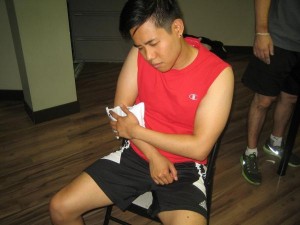 Bone injuries, such as fractures and dislocation, require immediate first aid treatment. Many accidents often lead to broken bones, so it is important that first aiders know how to manage these first aid situation.
Bone injuries, such as fractures and dislocation, require immediate first aid treatment. Many accidents often lead to broken bones, so it is important that first aiders know how to manage these first aid situation.
One of the primary goals in the management of fracture is the reduction of swelling. To achieve this goal, the PRICE (Protection, Rest, Ice, Compression, and Elevation) technique is used in the management of fractures. Application of cold can help in a number of ways. It can help decrease pain, cause the constriction of blood vessels, minimize bleeding and swelling, and decrease the metabolism of the affected cells. Moreover, the physical application of ice causes a numbing effect on the sensation thus reducing pain experience.
Besides the RICE technique, emergency splinting is also very important in ensuring positive outcome and preventing complications due to broken bones. Splinting is the procedure for immobilizing fractured bones. Splints can be made of rigid or soft materials. There are many different commercial splints that are often used by emergency medical professionals. However, you can use any item available at the scene of accident to splint a fracture.
There are other types of splints that are often used such as air splints and traction splints. Air splints are a special type of splints that can be fitted onto the patient’s extremity and then inflated to immobilize the bone. Meanwhile, traction splints apply pulling force on the bone to stabilize it. This type of traction requires special equipment and training. However, manual traction can also be use.
Here are some general principles to follow when using splints.
- When unsure, splint.
- Splint from one joint above and below the fracture to completely immobilize the bone.
- Splint the broken bone in the position it is originally found.
- Individuals who suffer from fractures or dislocations should be monitored and treated for shock.
- When using rigid splint, make sure to pad the splint first before applying to the victim.
- When splinting an extremity, start wrapping from the farthest then going closer to the body.
- Make sure not to disrupt the blood circulation and nerve function of the affected extremity. Regularly check the pulse and nerve function below the affected or splinted extremity. To check for nerve function, ask the patient if there is any change in sensation.
- Observe the color and temperature of the skin below the affected extremity.
- When splinting the forearm and hand, the hand should be in functional position.
- If possible, elevate the affected extremity after being immobilized to minimize swelling.
